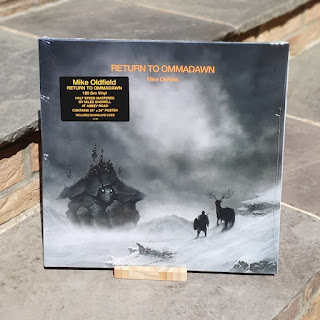"Return to Ommadawn" is the final LP by Mike Oldfield and was released in 2017. Here I am playing the standard 180g black vinyl that was available across Europe.
The first I heard of this album was when an excerpt was played on the radio. For some reason the piece that was played featured a VST generated Clavioline playing a tune akin to "Telstar". Whilst this all sounded very cheesy to my ears, I was still keen to hear the finished album as it promised something of a return to Mike's roots.
Thankfully, when the album was finally released there was no sign of the "Telstar" rip off and only a short section on the second side of the album bore any resemblance to the music I had heard on the radio. This album was actually much better than I anticipated and I have a strong memory of commuting through heavy traffic during the winter whilst listening to it and thinking, "It's good to have Mike back.". Like everyone else, I had no idea this would be the last album we would hear from the great man.
The opening of part one of "Return to Ommadawn" sees penny whistles playing a theme that is soon superseded by a whole raft of ideas and musical passages that contrast in mood. Yes, there are blank spaces and some slightly puzzling pauses, but people have been happy to forgive far worse on previous records (I'm talking about you "Zombies") so I really don't have a problem with this. I adore the theme that develops after about ten minutes, with the only sour note being the use of a reversed sample of the vocals from the original "Ommadawn" which are undoubtedly a misstep.
The reverse of the disc is just as good as the first, but it does take some time to get going. The first glimpse of a melody emerges after about two minutes but it is snuffed out before being fully developed. At 7'43 the "Victory" theme that was originally teased on the radio arrives, but it is much more restrained and mercifully abandons the Clavioline sound. More passages come and go before the main theme returns and signs off with a little jig.
Inevitably people compare this album to the original "Ommadawn" or even "Hergest Ridge" and regard it as somewhat lesser. Personally I consider "Return to Ommadawn" better in many respects and enjoy it immensely. No doubt such an opinion is close to heresy for Oldfield officianodos but I don't have strong bond with those older recordings and this record just sounds good to my ears. 4/5





















